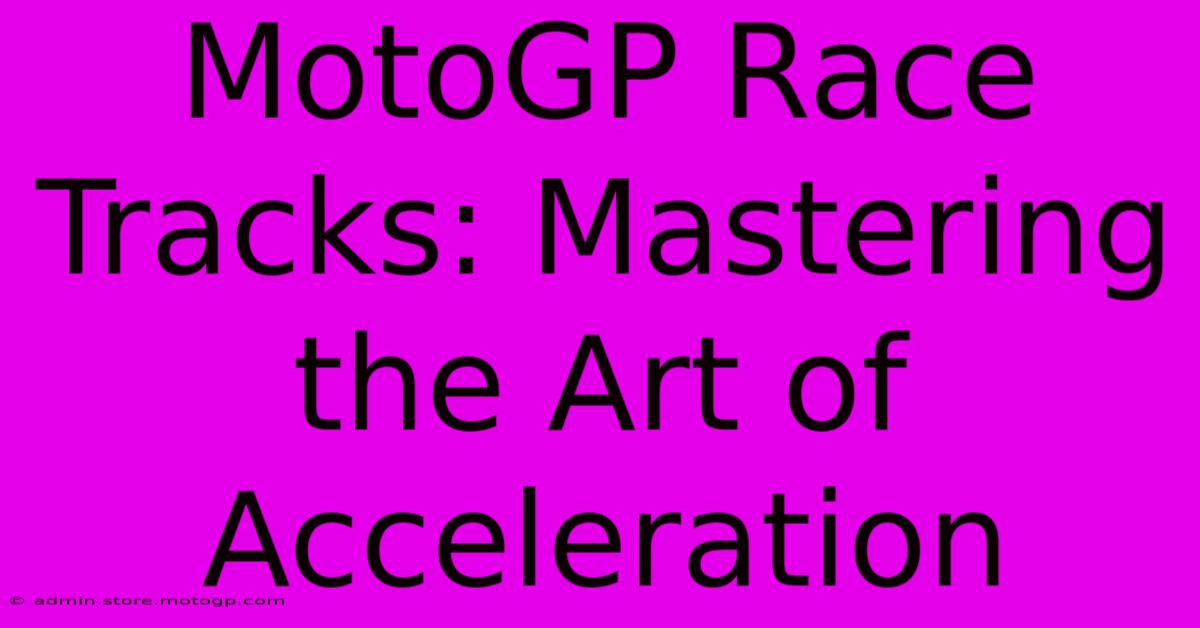MotoGP Race Tracks: Mastering The Art Of Acceleration

Table of Contents
MotoGP Race Tracks: Mastering the Art of Acceleration
MotoGP, the pinnacle of motorcycle racing, demands perfection. While cornering skills and braking precision are crucial, acceleration is the key to unlocking victory. This isn't just about horsepower; it's about harnessing power effectively across the diverse and demanding race tracks on the MotoGP calendar. Let's delve into how riders master the art of acceleration on these iconic circuits.
Understanding the Acceleration Phases
Effective acceleration in MotoGP isn't a single, continuous burst of speed. It's a nuanced process broken down into several distinct phases:
1. Corner Exit: The Crucial First Step
The acceleration phase begins before the bike is even straight. Riders must smoothly transition from lean to upright, finding the perfect balance between stability and momentum. This requires impeccable throttle control, utilizing the bike's electronics to manage wheelspin and maintain traction. Tracks like the Red Bull Ring in Austria, with its long straights, make this phase particularly important; a smooth exit can dramatically impact top speed.
2. Mid-Acceleration: Power Delivery
Once upright, the rider needs to progressively increase throttle input, carefully managing power delivery. This demands a deep understanding of the engine's characteristics and the track surface. Grip is paramount here. The Sepang International Circuit in Malaysia, known for its hot and humid climate affecting tire grip, presents a unique challenge.
3. Top-End Speed: Maintaining Momentum
Reaching top speed is crucial, but maintaining it is equally important. This phase often involves subtle adjustments to body position and throttle control to minimize drag and maximize speed. The long straights of tracks like the Autodromo Internacional do Algarve in Portugal, mean riders need to focus on maintaining maximum velocity.
Race Track Specifics: Acceleration Strategies
Different tracks demand distinct acceleration strategies:
Tight and Twisty Tracks: (e.g., Assen TT Circuit)
These circuits prioritize smooth power delivery and precision over raw power. Riders must be adept at managing traction, avoiding wheelspin, and smoothly accelerating out of tight corners. Precise throttle control and excellent bike setup are paramount.
Fast and Flowing Tracks: (e.g., Mugello Circuit)
Here, maximizing top speed is paramount. Long straights and sweeping corners allow for longer acceleration phases. Powerful engines and precise aerodynamic set-up become highly beneficial. Riders focus on achieving a powerful launch and maintaining momentum.
Stop-and-Go Tracks: (e.g., Circuit of the Americas)
These tracks feature a mix of tight and flowing sections, demanding adaptability. Riders must switch seamlessly between precise throttle control for corner exits and powerful acceleration for the longer straights. The ability to rapidly adjust to changing conditions is key.
The Role of Technology in MotoGP Acceleration
Modern MotoGP bikes utilize sophisticated electronics to aid acceleration:
- Traction control: Prevents wheelspin, ensuring optimal power transfer to the ground.
- Engine braking management: Controls engine braking to improve stability during transitions.
- Launch control: Helps riders achieve perfect starts from the grid.
- Anti-wheelie control: Prevents the front wheel from lifting during aggressive acceleration.
These systems, while incredibly helpful, still require expert rider input to be used effectively.
Conclusion: Beyond the Throttle
Mastering acceleration in MotoGP is more than just twisting the throttle. It's a complex interplay of bike setup, rider skill, track characteristics, and cutting-edge technology. It's a continuous evolution, a pursuit of perfection that separates the champions from the rest of the field. The skill of achieving rapid acceleration on varied race tracks is truly what defines a MotoGP legend. The next time you watch a race, pay close attention to how the riders manage acceleration – you’ll see a level of finesse that is both breathtaking and captivating.

Thank you for visiting our website wich cover about MotoGP Race Tracks: Mastering The Art Of Acceleration. We hope the information provided has been useful to you. Feel free to contact us if you have any questions or need further assistance. See you next time and dont miss to bookmark.
Featured Posts
-
Sting F1 Setting New Standards In Racing
Feb 19, 2025
-
Best Moto Gp Riders Inspiring The Next Generation
Feb 19, 2025
-
The Fastest Way To Cota Pre Purchase Your Parking Pass
Feb 19, 2025
-
Austin Gp Sprint Race A True Test Of Character
Feb 19, 2025
-
F1 Parking Pass The Insiders Secret
Feb 19, 2025
